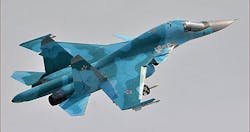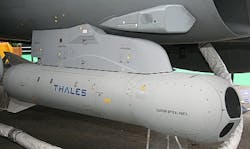Sukhoi gets contract to build latest lot of Su-34 jet fighter bombers as part of 92-aircraft deal through 2020
MOSCOW, 4 March 2012. The Ministry of Defence of the Russian Federation in Moscow has signed a contract with Sukhoi Co. JSC in Moscow to build the latest production lot of 32 Su-34 jet fighter-bombers for the Russian air force, Sukhoi officials announced. The Su-34, which NATO calls the Fullback, is being designed to replace the Sukhoi Su-24 Fencer and the Tupolev Tu-22M Backfire bombers as Russia's front-line jet strike fighter.
This production lot is part of a contract for Sukhoi to deliver 92 Su-34 frontline bombers over the next eight years. This latest series production of the aircraft will be at the Sukhoi Novosibirsk Aircraft Production Association (NAPO) in South-Central Russia. No monetary amount of the contract was released.
This is one of the largest contracts for combat aircraft under the Russian State Armament Program for 2011 to 2020, Russian military officials say. The state contract guarantees Sukhoi and its subcontractors a high production load and will help boost the company's development in the long term, officials say.
Russian military forces formally accepted the Sukhoi Su-34 design after competing aircraft testing last September. The Su-34 is designed to attack land-based targets, ocean-going vessels, other aircraft, and missiles during the day and at night in all weather with precision-guided munitions.
Development of the Su-34 -- a derivative of the Russian Su-27 Flanker jet fighter -- began in 1990, and the first production-quality model first flew in 1994. The aircraft has the Leninets OKB-designed B004 radar, as well as a rearward-facing warning radar.
The aircraft has computers that process and combine data inputs from sensors such as front- and rear-facing radar systems, thermal imaging, daylight camera, data link, radar homing and warning system, and missile warning systems.
Other Su-34 avionics include liquid crystal display panels for the weapons systems operator. Avionics help the tandem-seat aircraft deploy countermeasures, follow terrain in low-level flight, and fly in formation with other aircraft.
The Su-34's radar systems can track airborne and surface targets and provide navigation and mapping information for ground mapping, automatic terrain following, and terrain avoidance. It's air-to-air radar is believed to have a range of 125 to 150 miles.
The Su-34 is believed to have the Thales Damocles electro-optical targeting and reconnaissance system, which may be the first piece of Western equipment approved for integration with Russia's combat aircraft and produced in Russia under an official licence with its manufacturer, Thales Group in Neuilly-sur-Seine, France.
The Su-34 also has 12 pylons able to carry nearly nine tons of ordnance, including the latest Russian precision-guided weapons. The aircraft also carries a 30-millimeter cannon, subsonic and supersonic homing missiles, and glide bombs able to destroy hardened and well-camouflaged targets.
For more information contact Sukhoi online at paste link phrase here, the Russian Ministry of Defence at www.eng.mil.ru, or Thales Group at www.thalesgroup.com/defence.
About the Author
John Keller
Editor-in-Chief
John Keller is the Editor-in-Chief, Military & Aerospace Electronics Magazine--provides extensive coverage and analysis of enabling electronics and optoelectronic technologies in military, space and commercial aviation applications. John has been a member of the Military & Aerospace Electronics staff since 1989 and chief editor since 1995.

